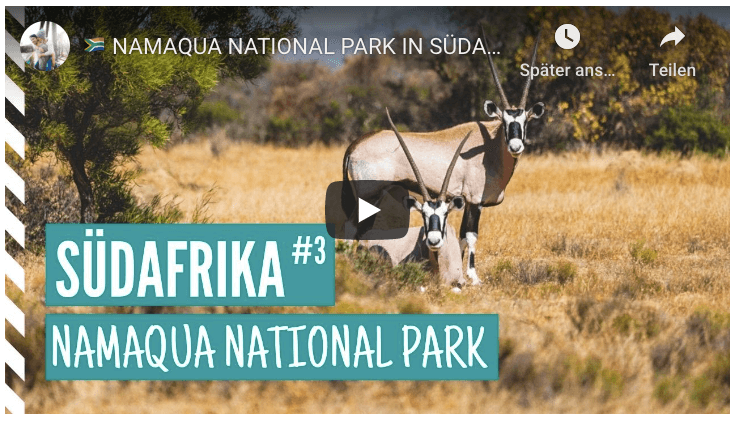During our tour through the Northern Cape of South Africa, we also stopped in the beautiful Namaqua National Park. Located here in the heart of Namaqualand, the park is a popular destination for thousands of tourists, especially in spring. This is due to the wildflower bloom in the peak months of August and September. Then the entire landscape transforms into a colorful sea of flowers.
The park itself also awaits you with a mountain landscape up to 1,700 meters high, a diverse flora, and many park inhabitants, such as baboons, jackals, porcupines, meerkats, zebras, oryx antelopes, cliff divers, and even leopards. Today we’ll tell you what you can expect in Namaqua National Park, what accommodations are available and what activities you can do.
What else you should know
- Best time to travel to South Africa
- Currency of South Africa
- South Africa Entry & Visa
- Round trip with a rental carcarcar
- The top Cape Town highlights
- Northern Cape Round Trip
- Kruger National Park
- Panorama Route South Africa
- The beautiful Winelands
- Magical Garden Route
- What else you should know
- General information about the park
- Animals & plants
- Wildflowers in bloom in spring
- Activities in the park
- Admission and opening times
- Best time to visit
- Arrival & rental car
- Our accommodation
- Other accommodation
- Shopping & Food
- Conclusion: Namaqua National Park
- Our video diary
General information about the park
When the flowers are not in bloom, the landscape appears barren, and at first it’s hard to believe that over 3,500 plant species call this region home. At times, we felt like we were on Mars. But that’s precisely what makes this region special.
The best place to start your trip through the park is at the main entrance (accessible via Kamieskroon). There you’ll find a reception desk, information material, and contact persons. From there, you can take a 5-kilometer circular drive or start various hikes. You can also start your exploration tour from here in your car and just go with the flow.
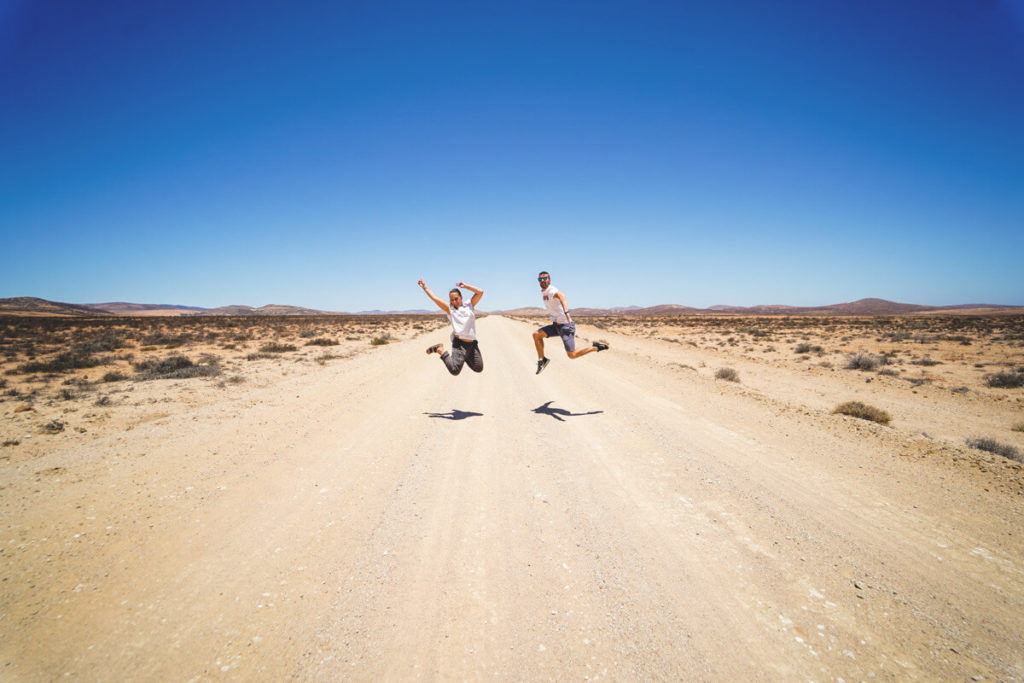
Plan at least 5 to 6 hours; the routes are long, and you won’t make much progress. Be prepared to see hardly any other visitors during the off-season. We only encountered one car in the park in 6 hours. If you want to drive the routes all the way to the sea, you should plan considerably more time.
Here, however, you’ll find beautiful sand dunes (Biterrrivier Dune Field), the turquoise ocean, a seal colony, oystercatchers, dolphins in the sea, and rugged cliffs and rocks. We would have loved to see this scenery, but didn’t have enough time.
Animals & Plants
Namaqua National Park is home to many animals, such as cliff divers, baboons, steenboks, jackals, leopards, spoonbills, turtles, meerkats, oystercatchers, dolphins, oryx antelopes, porcupines, and 150 different bird species (e.g., the black harrier).
More than 3,500 plant species can be found here, of which more than 1,000 are endemic and found only in this park. Keep an eye out for the quiver trees, which are characteristic of the Northern Cape. In the official park brochure, you’ll find all the information you need about the park’s animals and plants.
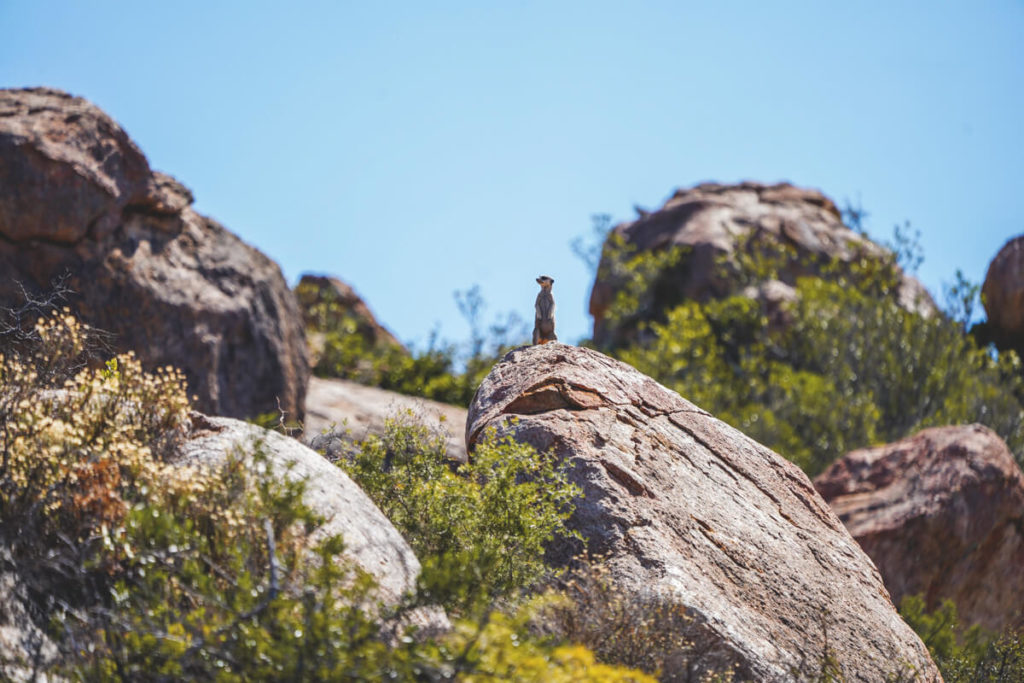
We really wanted to finally see the beautiful Oryx antelopes, which we had never seen before in South Africa. Namaqua National Park was our first stop during our trip through the Northern Cape, where we encountered some of these beautiful animals (Gemsbok) right at the beginning.
These eland animals live primarily in the arid and semi-arid regions of Africa, as well as on the Arabian Peninsula. Their black facial mask, long horns, and attractive fur pattern are particularly beautiful.
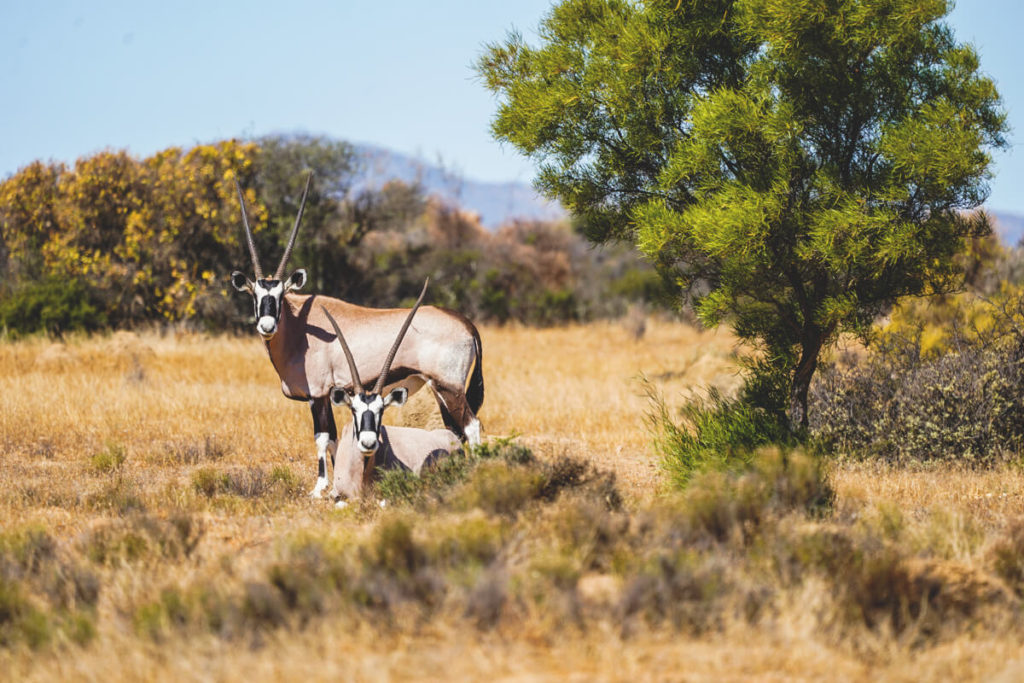
Wildflower bloom in spring
This area is especially popular between July and September, when the winter rains transform the dry and barren land into a colorful carpet of flowers made up of millions of tiny plants. During this time, you should drive through the park with your rental car or choose one of the hiking trails and enjoy the view. However, you can never say exactly when this spectacle will take place; it depends entirely on the rain.
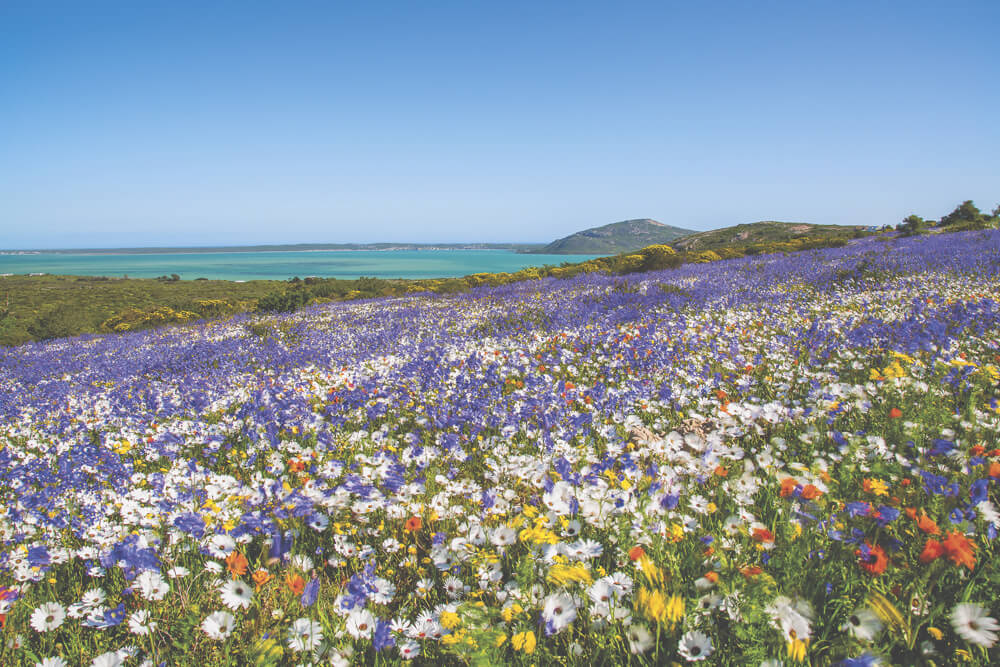
There’s even a flower hotline where you can inquire about the status and the best spots (+27 – (0) 21 – 4183705). Outside of these months, you’ll have the park almost entirely to yourself, as we did. The best time of day during the blooming season is supposedly between 10 a.m. and 4 p.m. This is when most of the flowers are open and in full bloom. We’ve never experienced the region at this time of year, but hope to witness the bloom one day.
Activities in the Park
In Namaqua National Park, you can explore the park on your own with your car, as we did. The roads lead to various viewpoints. The information center provides detailed information about the park, its trails, and its highlights. Other activities in the park include mountain biking, bird watching, hikes (Skilpad Walking Trail, Korhaan Walking Trail, Heaviside Hiking Trail) and the Caracal Eco Route.

There are also 4×4 routes in the park that take you to the sea, where you can discover shipwrecks, among other things. The possible routes are clearly shown in the “Visitors Map.” You can get this free of charge at the information desk. For certain activities in the park you need a permit, such as the Caracal Eco Route. You can get this at the park entrance. If you make it to the sea, be sure to look out for the rare Heaviside’s dolphins.
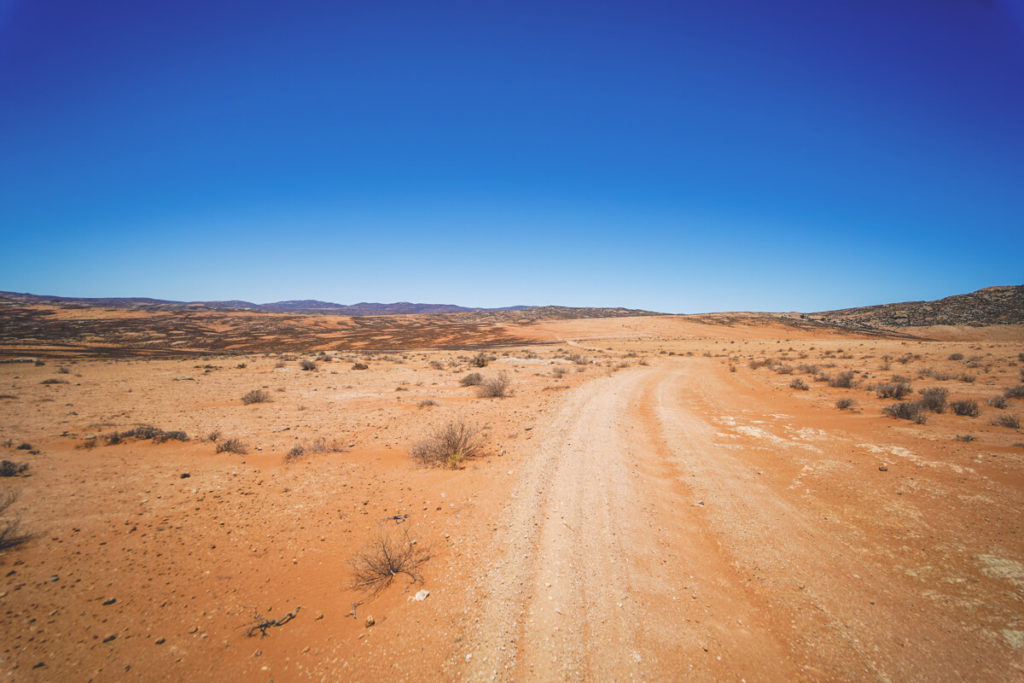
Entry and Opening Times
- Address: XHMH+8J Soebatsfontein, South Africa
- Opening Times: Groenrivier Entrance Gate 8am – 5pm | Skilpad Rest Camp 7:30 a.m. – 4 p.m.
- Entrance fees: Adults R110, children R55
- Duration: We recommend 1 day in the park

Best time to travel
The good news: According to online climate tables, you can travel to this region all year round. Rain clouds hardly ever form on the west coast of South Africa, which is why the region is considered a semi-desert. Even in winter (June – August), temperatures here rise to 20°C, although it can get very cold in the evenings. In summer (December – March), the region is very hot, with temperatures well over 30°C. As already mentioned, most visitors come in August and September (spring) for the wildflower blooms.
We were in Namaqualand in November and had very good weather every day, with some hot temperatures. However, since we were only in the car in the park itself, these temperatures were bearable with air conditioning. For hikes, it’s probably best to use the early morning hours when it’s not so hot. Outside of the blooming season, the landscape is very dry and barren, which, however, has its charm.
Arrival & Rental Car
Namaqua National Park is located approximately 21 kilometers from Kamieskroon and just under 50 kilometers from Springbok. The best way to get there is from the south (Cape Town) up the west coast on the N7 to Kamieskroon. Drive through the town, past the Kamieskroon Hotel, and continue straight ahead until you see the brown SANParks sign, where you should turn left. Now, drive along gravel roads to the main entrance, “Skilpad Entrance.”

You can generally drive through the park with a regular car, but we recommend a four-wheel drive. Driving on the gravel roads is much more relaxing, and you can even go a bit faster. It’s important to fill up your car beforehand. As far as we know, there is no gas station in the park. You should also bring your binoculars, charged batteries for your camera, and plenty of drinks and snacks.
Our Accommodation
Good starting points for exploring the park are Springbok, Naries Namakwa Retreat, Kamieskroon, and Garies. We stayed at the beautiful Naries Namakwa Retreat*, which is about 27 kilometers from Springbok. Despite arriving very late (around 10 p.m.), we received a very friendly welcome. We stayed in the main building in a really nice double room. There are also large family cottages and unique stone houses.
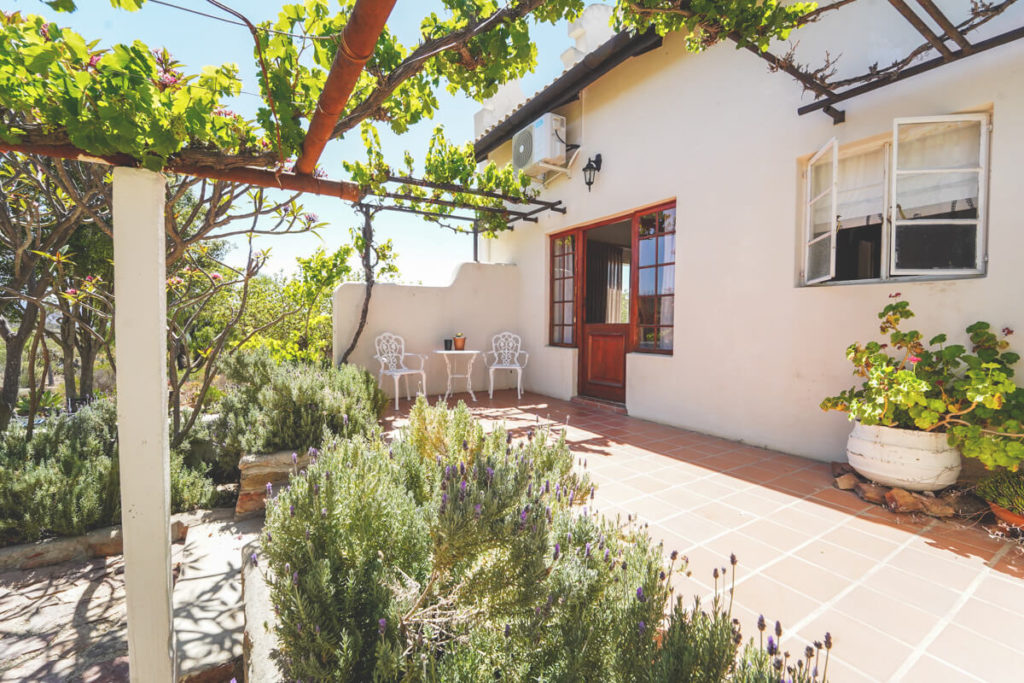
Idyllic Location
The secluded location, the peace and quiet, as well as the beautiful garden with trees, flowers, cacti, a small pool, sun loungers, a fountain, and hiking trails are particularly beautiful. When it’s not incredibly hot, you can sit on the terrace and gaze into the distance. The main building houses a library with a lounge, the dining room, and the reception. We were able to park our car right in front of our room with a terrace.

The Room
The room was very cozy with high-quality furniture and a large, beautiful bathroom with a shower and bathtub. The many traditional African details are particularly lovely. Since we missed dinner on the day of arrival, we even had huge plates full of delicacies brought to our room.
The bed was huge and super comfortable, plus there were plenty of pillows and, above all, a nice thick blanket. It gets quite cold in the desert region, especially at night. In winter, there are also heaters and electric blankets.

Fantastic Food
For breakfast, there were croissants, bread, fruit, spreads, cheese, sausage, yogurt, cereal, juices, tea, coffee, and other delicacies. For dinner, we could choose from two different three-course menus. Afterwards, we were almost bursting because there was so much food and it tasted so good. If you’re staying in the cottages, you can prepare your own meals in the fully equipped kitchen. To be honest, we were quite happy that we had half board and didn’t have to worry about anything.
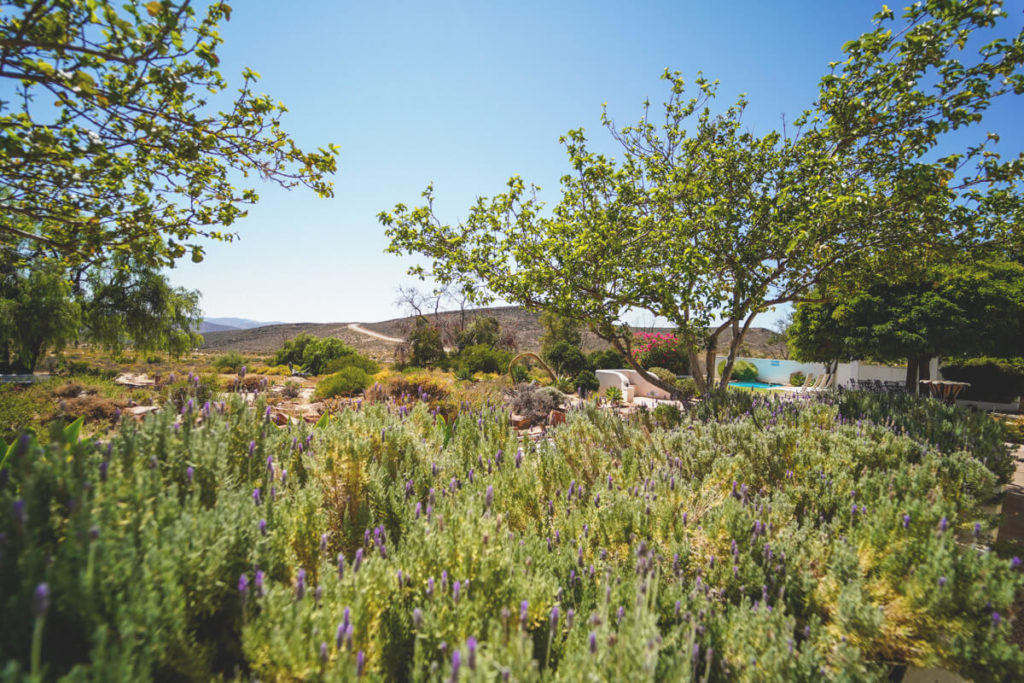
Other Accommodation
Of course, there’s more than just the Naries Namakwa Retreat. You can stay at several other accommodations, most of which are located in Springbok and the surrounding area. You can also stay at the rest camps in the park itself or at the camping sites with your own tent or caravan.
You can only book these through the official SANParks website. There are the Skilpad Rest Camp, the Luiperdskloof Guest Cottage, the Namaqua Flower Camps, and the Coastal Camp Sites. At least, that’s how it’s marked on the area map.
Shopping & Food
We did our shopping in Springbok. There, in addition to ATMs and gas stations, you’ll find well-stocked supermarkets such as Shoprite, Spar, OK Foods, and Checkers. Alternatively, you’ll only find an OK Foods shop in Garies. Before you enter the national park, you should stock up on snacks and, above all, drinks there.
In the park itself, there’s only the Happy Valley Shop in Soebatsfontein (Update 04/2024: permanently closed), when it’s open. As already mentioned, we can also recommend the food at the Naries Namakwa Retreat. The breakfast and dinner were truly amazing!
Conclusion: Namaqua National Park
If you absolutely want to see the flowers in bloom, you should definitely travel to this region in August and/or September. Unfortunately, we were there outside of this time (November), so we had to settle for a barren, rather dreary landscape. That sounds so negative, but we don’t mean it that way. We like these types of landscapes, semi-deserts and deserts.
If you don’t like that, you should generally consider whether the Northern Cape is the right choice for you. The park itself is easy to reach, there are good hiking trails, and even a few animals to see. We particularly liked our accommodation, which was beautifully located “off the beaten track.” Here you can relax, unwind, and gaze at a breathtaking starry sky. We can definitely recommend a trip to this area.
Our video diary
